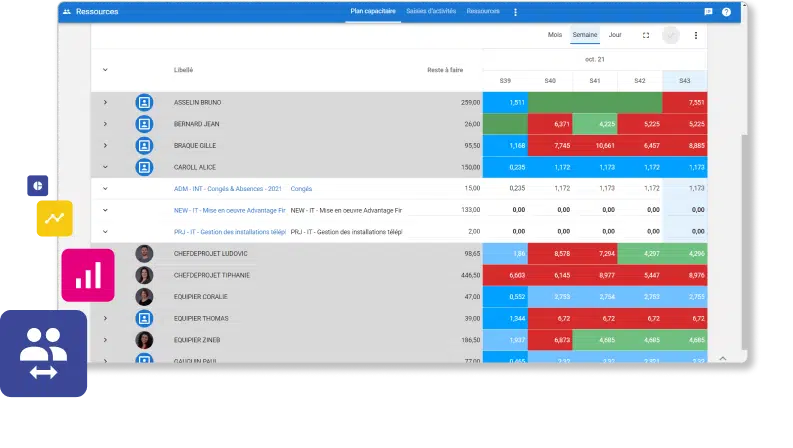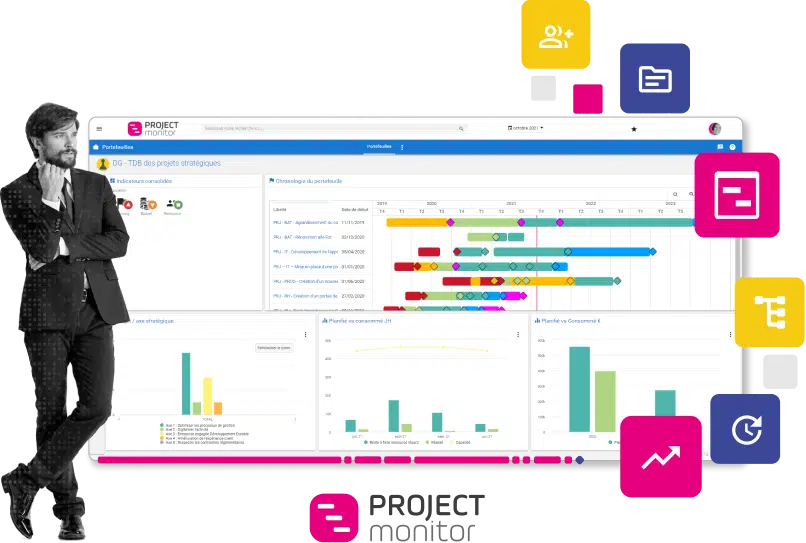What is the load factor?
The "workload rate" is an essential indicator for planning and monitoring resources and projects. It represents the ratio between a resource's effective working time and its actual work capacity.
In this article, we explain in detail:
- what the load factor is,
- how to calculate it,
- why it's important,
- why it requires meticulous monitoring of working hours.
Load rate definition
Load factor, also known as occupancy rate, represents the ratio between an employee's (or resource's) effective working time and the total working time available. It is generally expressed as a percentage. The load rate is a valuable tool for determining whether a resource is under-utilized (low load rate) or over-utilized (high load rate).
How do you calculate the load factor?
The load factor is calculated quite simply, using the following formula:
Load factor = (Actual working time / Total available working time) * 100
For example:
- An employee works 35 hours in a 40-hour week, his workload is (35/40)*100 = 87.5%.
- An employee works 42 hours in a 38-hour week, his workload is 110.5%. The employee is in a situation of over-utilization.
Why calculate a load factor?
Calculating the load factor is essential for several reasons.
It allows :
- optimize resource utilization, by highlighting situations where resources are overloaded or under-utilized.
- better plan and manage projects, by anticipating resource requirements and adapting workloads accordingly.
- improve employee well-being, by avoiding situations of work overload that can lead to stress or burnout.
💡 When the load rate exceeds 100%, this means that the resource is overloaded with work. In such situations, it is imperative to readjust the workload. This can be done in a number of ways, such as smoothing out tasks over a longer period. Another possible solution is to add other resources to spread the workload. This can be done by recruiting new team members or outsourcing certain tasks. The aim of these adjustments is to ensure the well-being of employees while maintaining the company's productivity.
The importance of meticulous time tracking to calculate load factors
Precise calculation of the load factor is based on rigorous monitoring of working hours. Herein lies the complexity of this approach. Time tracking must take into account not only the time spent on assigned tasks, but also the time spent on unplanned tasks, interruptions, break times, etc. Meticulous time tracking provides an accurate and reliable workload rate, reflecting the reality of the employee's work and enabling optimum management of resources.
Which software to use to calculate load factors?
Project Monitor is project portfolio management (PPM) software that can make calculating and tracking workloads much easier. Here's how:
- Real-time visualization: Project Monitor offers real-time visualization of each team member's workload. This enables project managers to see immediately if a person is over- or under-utilized, and adjust the workload accordingly.
- Forecasting: Project Monitor can help forecast future workloads based on current tasks and projects. This can help you plan ahead and avoid overload situations.
- Reporting and analysis: Project Monitor offers reporting and analysis capabilities, which can help to understand workload trends and identify areas for improvement.
- Resource management: In addition to load rate monitoring, Project Monitor offers tools for resource management, such as task planning, time tracking and resource assignment. This can help balance workloads and optimize resource utilization.

💡 To remember: PPM software such as Project Monitor not only makes it easy to visualize the load rate, but also to monitor and manage it more effectively. This can lead to better resource utilization, better project planning, and ultimately, better company productivity.
Other frequently asked questions about resources
How do you calculate the number of resources needed for a project?
Who allocates resources to the project?
What resources are needed to make a project a success?
How do you calculate a project's workload?
How to distribute the workload?
How do you smooth out the workload?
How to draw up a successful workload plan to effectively manage project resources?
Project Monitorresource & project portfolio management software
All the tools for resource management (and more). All in one software package.
Discover the features of Project Monitor, resource & project portfolio management software designed to meet the needs of PMOs, CIOstructures with more than 50 employees, or managing complex projects.
Easily manage over 100 active projects and pilot your action plans. Get a complete overview of what's happening in your project portfolio: resources, schedulebudget, dashboards.
